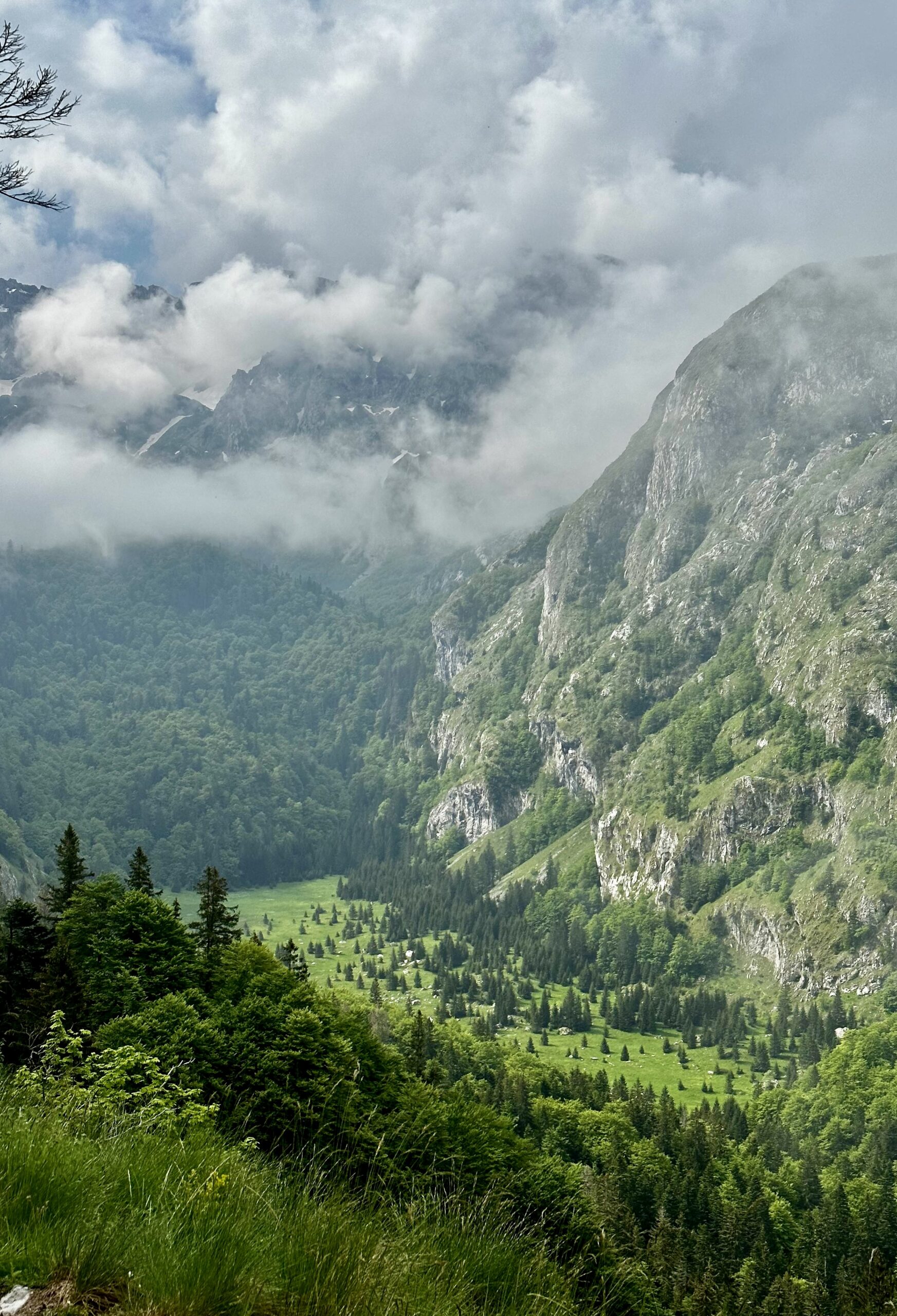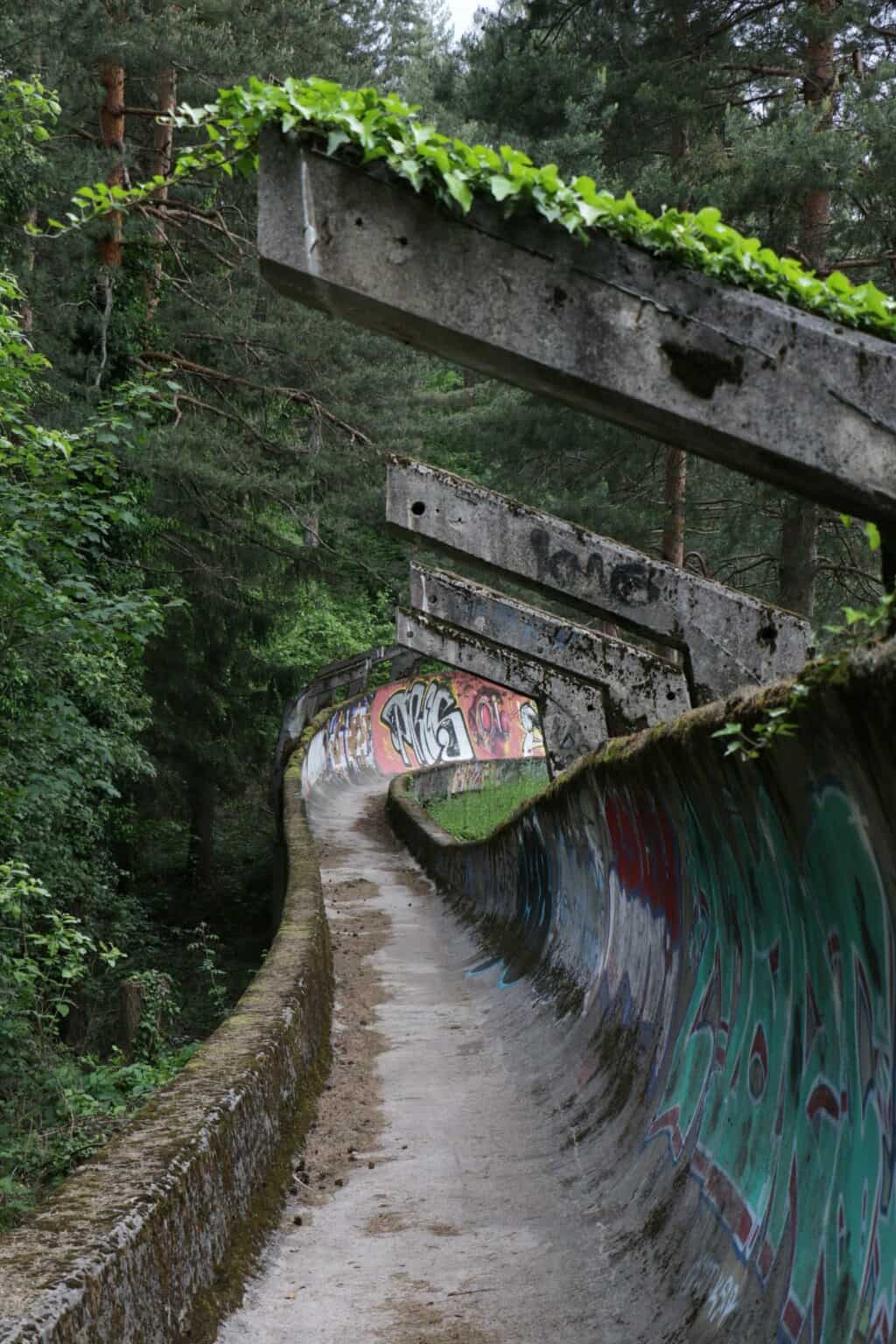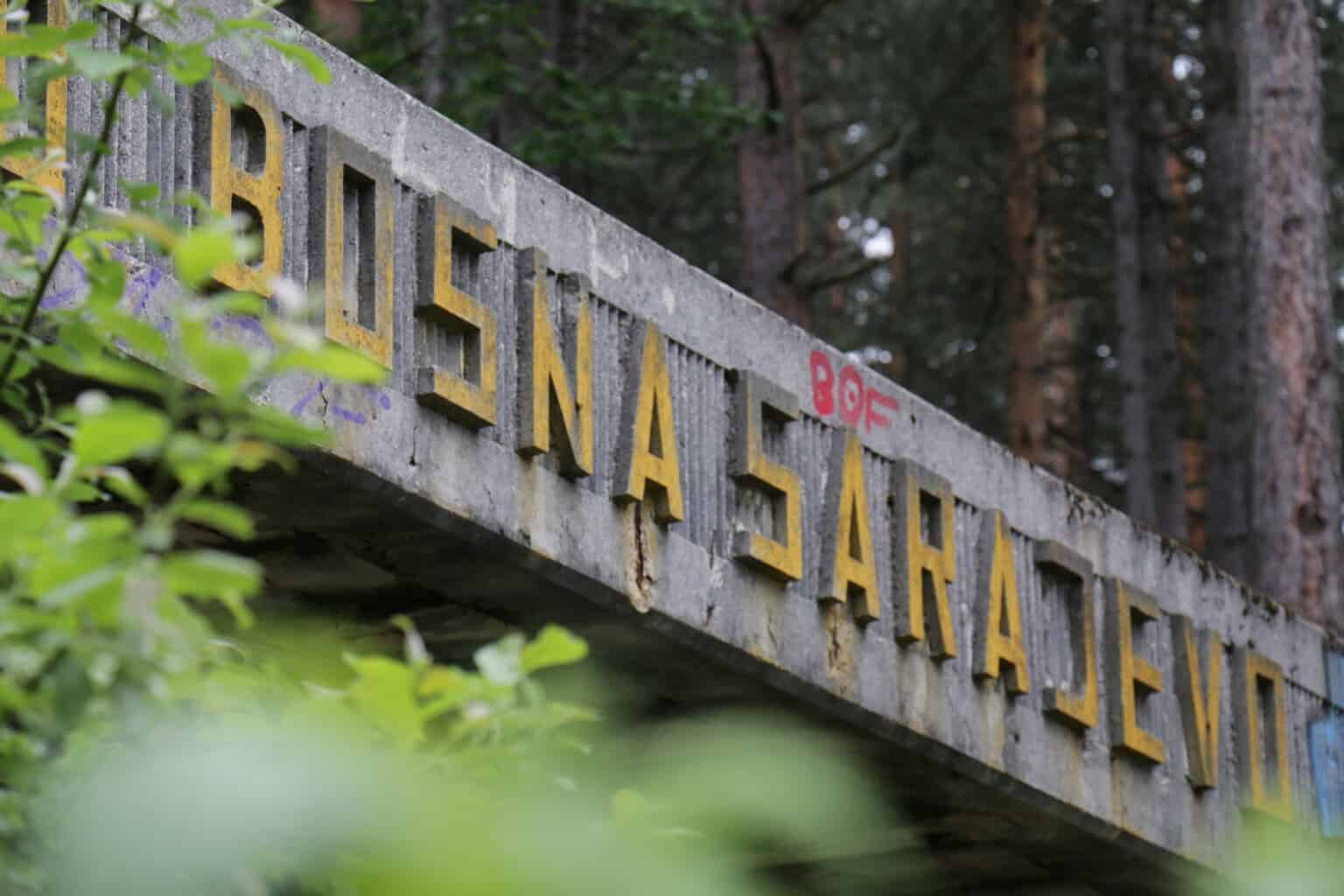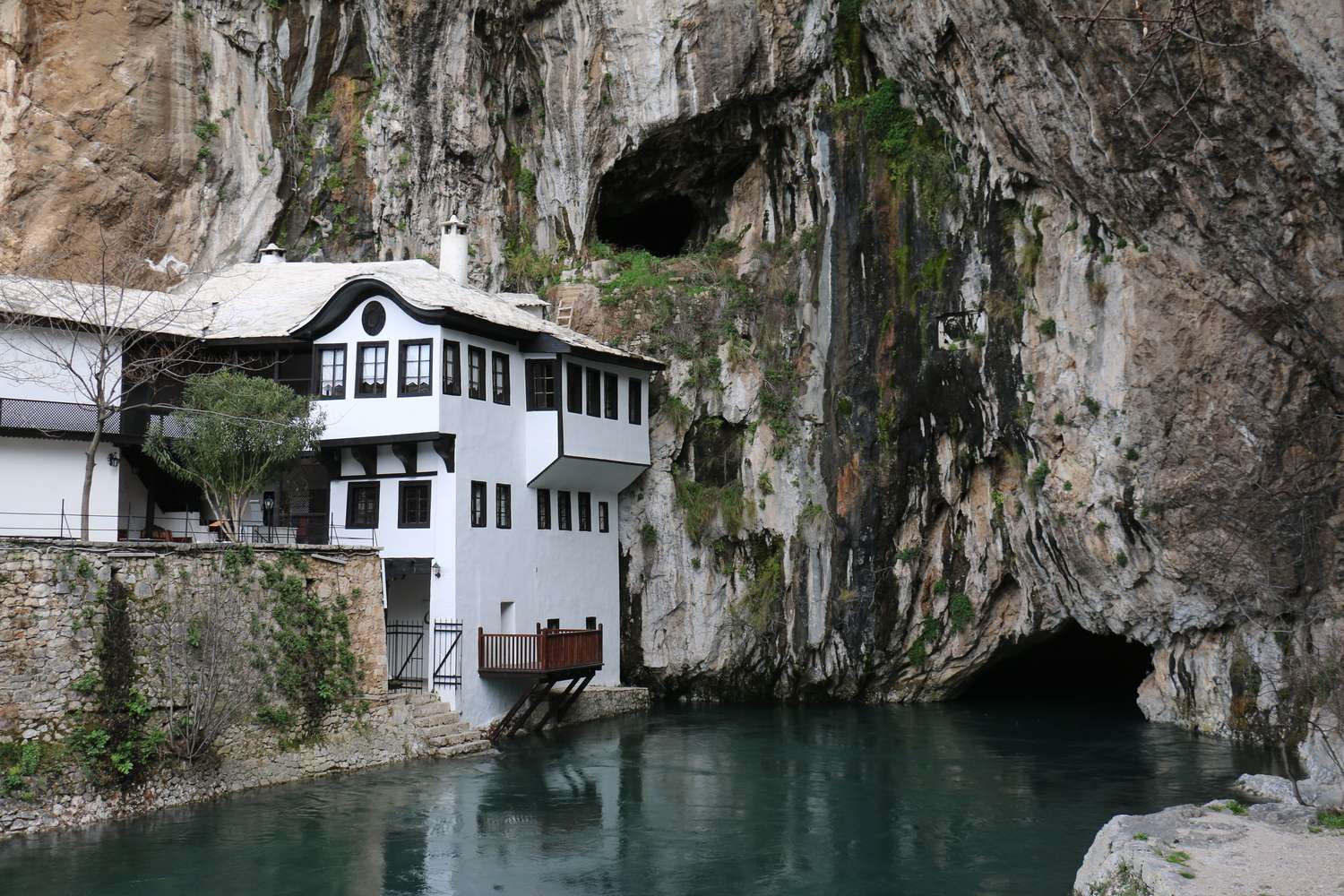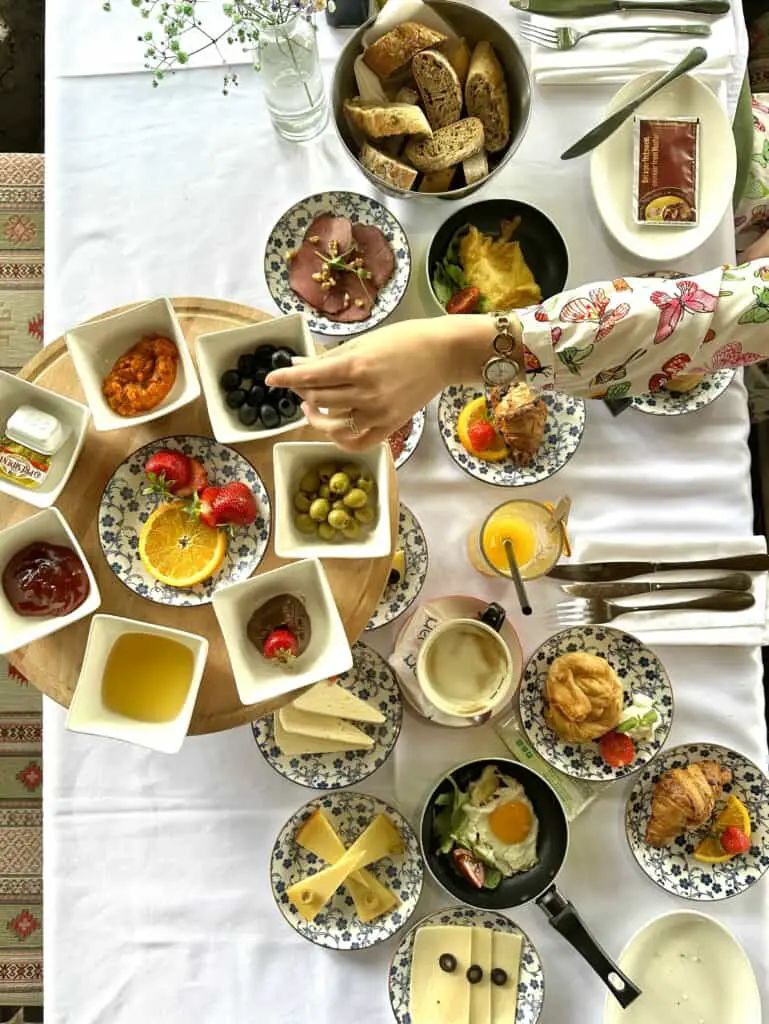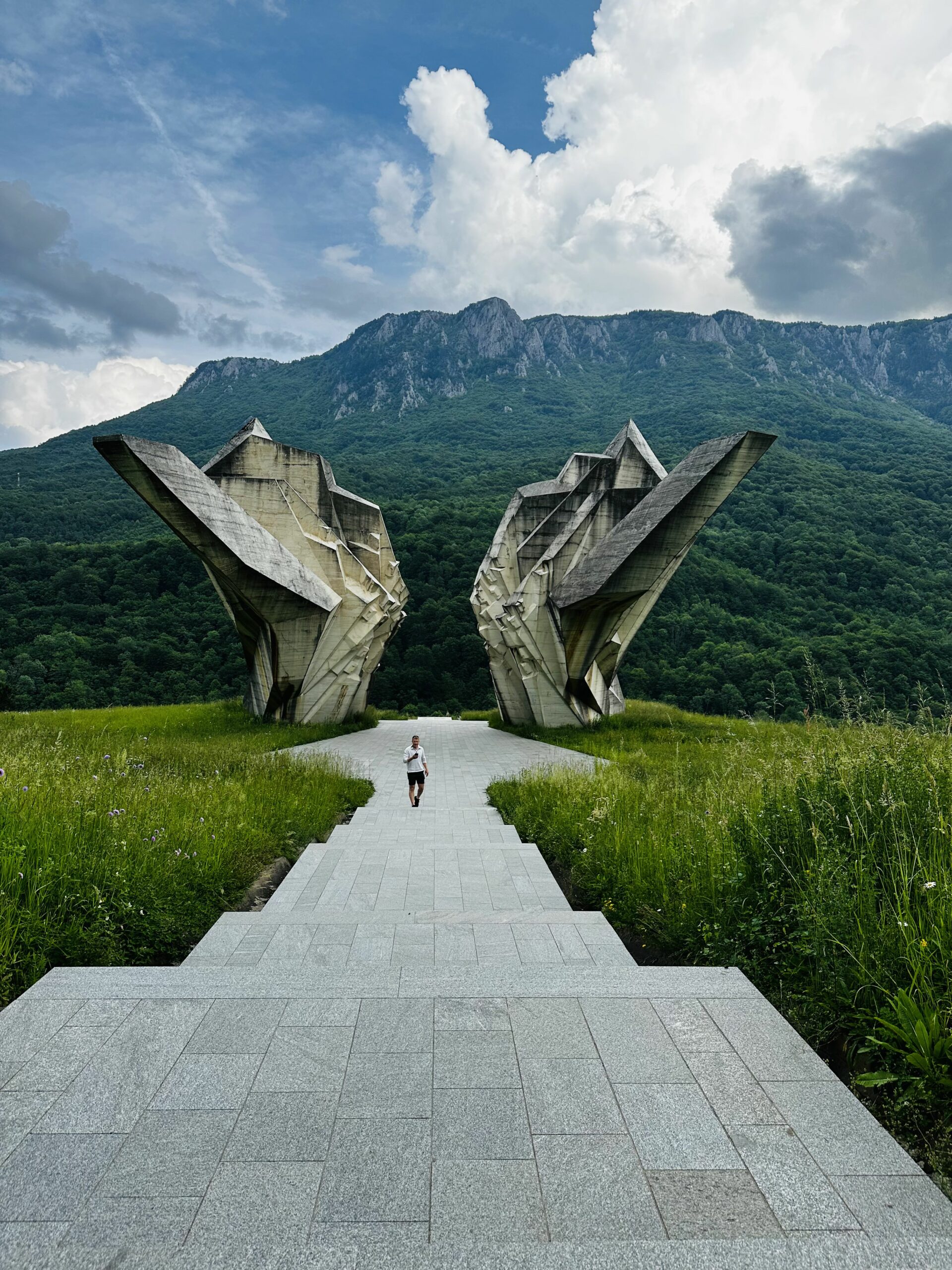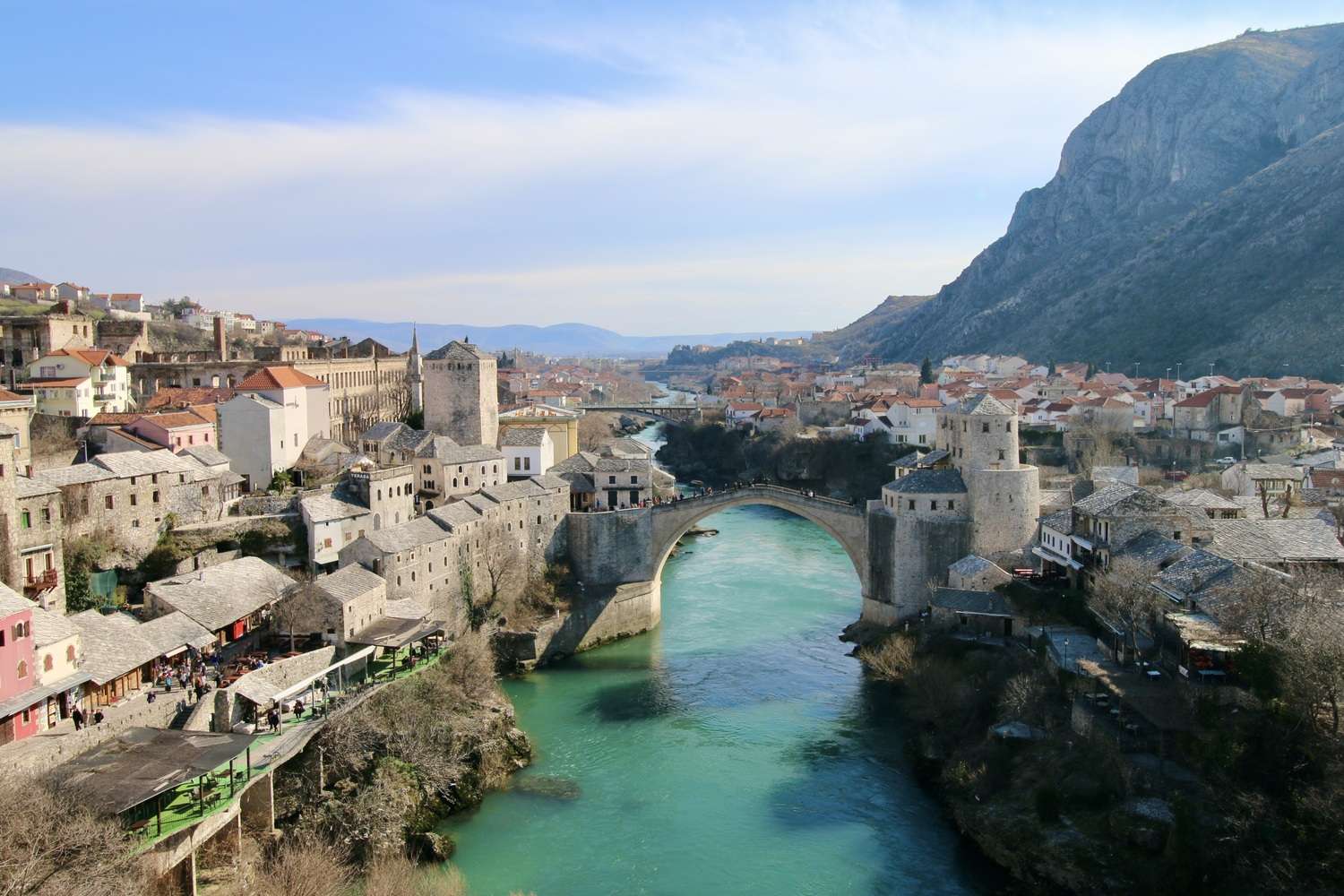Bosnia & Herzegovina Travel Guide
Please note that some of the links on our website are affiliate links. This means if you click on these links and make a purchase, we may receive a small commission at no extra cost to you. These commissions help us maintain and grow our blog.
Finally, Bosnia & Herzegovina! Where do I even begin? This is a truly “authentic” European destination, far removed from the overpriced beers, endless churches, and cobblestone old towns of more typical tourist spots. Yes, you’ll find some churches here, but Bosnia is a place for the adventurous traveler seeking something fresh and unique in Europe, far beyond the usual holiday in Spain.
I’ve visited Bosnia multiple times, and it’s one of those countries I keep returning to. It offers endless activities, breathtaking nature, cheap beer, and delicious food—all at an incredibly low cost!
Keep reading to discover everything you need to know about this stunning and underrated gem in the heart of the Balkans!
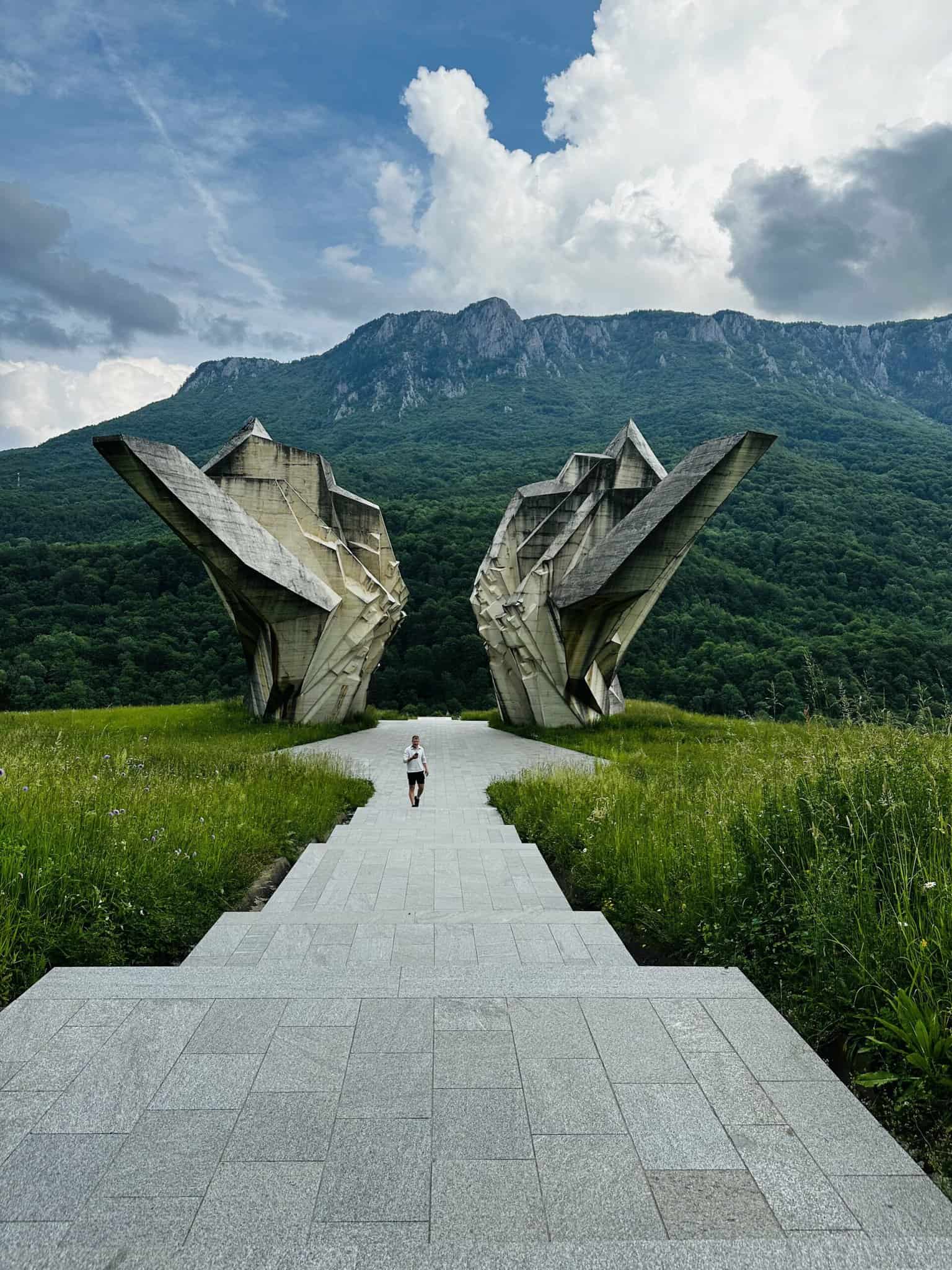
Table of Contents
A Quick History Lesson
Prehistoric and Roman Periods: The region has been inhabited since the Neolithic age, with Illyrian and Celtic tribes being some of the earliest known inhabitants. The Romans annexed the area in the 1st century AD, leaving behind significant archaeological remains such as roads, forts, and the pillars on which the bridge in the town of Konjic is built on.
Medieval Period: By the early Middle Ages, the area saw the formation of the medieval Bosnian state. Under the rule of Ban Kulin in the 12th century, Bosnia enjoyed a period of relative independence and prosperity. The Kingdom of Bosnia reached its peak in the 14th century under King Tvrtko I, expanding its territory and influence across the Balkans. This era was marked by the construction of many fortresses, monasteries, and stećci (medieval tombstones).
Ottoman Rule: In 1463, the Ottomans conquered Bosnia, incorporating it into their empire. This ushered in over 400 years of Ottoman rule, which profoundly influenced the region’s culture, architecture, and religion. The Ottomans introduced Islam, and many mosques, bridges, and caravanserais from this period still stand today. Sarajevo, the capital, was founded during this time and developed into an important cultural and commercial center.
Austro-Hungarian Rule: Following the decline of the Ottoman Empire, Bosnia & Herzegovina came under Austro-Hungarian control in 1878. This period brought modernization and significant infrastructural developments, including railways, schools, and administrative buildings. The Austro-Hungarian influence is evident in the architectural style of many buildings in Sarajevo and other cities.
20th Century Turmoil: The assassination of Archduke Franz Ferdinand in Sarajevo in 1914 sparked World War I. After the war, Bosnia & Herzegovina became part of the Kingdom of Serbs, Croats, and Slovenes, later known as Yugoslavia (Land of the South Slavs). During the interwar period, the region experienced rising ethnic tensions and political instability as part of the newly formed Yugoslav state. World War II brought further turmoil, with Bosnia & Herzegovina falling under the control of the Nazi puppet state, leading to widespread persecution and brutal conflicts among various factions. After the war, Bosnia & Herzegovina became one of the six republics of the Socialist Federal Republic of Yugoslavia under Josip Broz Tito.
Bosnian War and Independence: The breakup of Yugoslavia in the early 1990s led to the Bosnian War, a tragic conflict marked by ethnic violence and atrocities. The war resulted in significant loss of life and displacement of people. The Dayton Agreement, signed in 1995, brought an end to the war and established the current political structure of Bosnia & Herzegovina as an independent country divided into two entities: the Federation of Bosnia and Herzegovina and Republika Srpska.
Modern Era: Much of modern-day Bosnia is still impacted by the Bosnia war and much of the country is still divided with Croats making up large parts of the south of the country, Serbs living in the entity Republika Srpska, and Bosniak (Muslims) living in the Federation of Bosnia and Herzegovina. Furthermore, the scars of the war are still apparent everywhere you go in Bosnia & Herzegovina. Building in ruins and houses with bullet holes in them is a common sites in today’s Bosnia & Herzegovina. However, the country is slowly working towards a membership in he European Union and offers tourist stunning nature, historical cities and a truly unique blend of Eastern and Western influences.
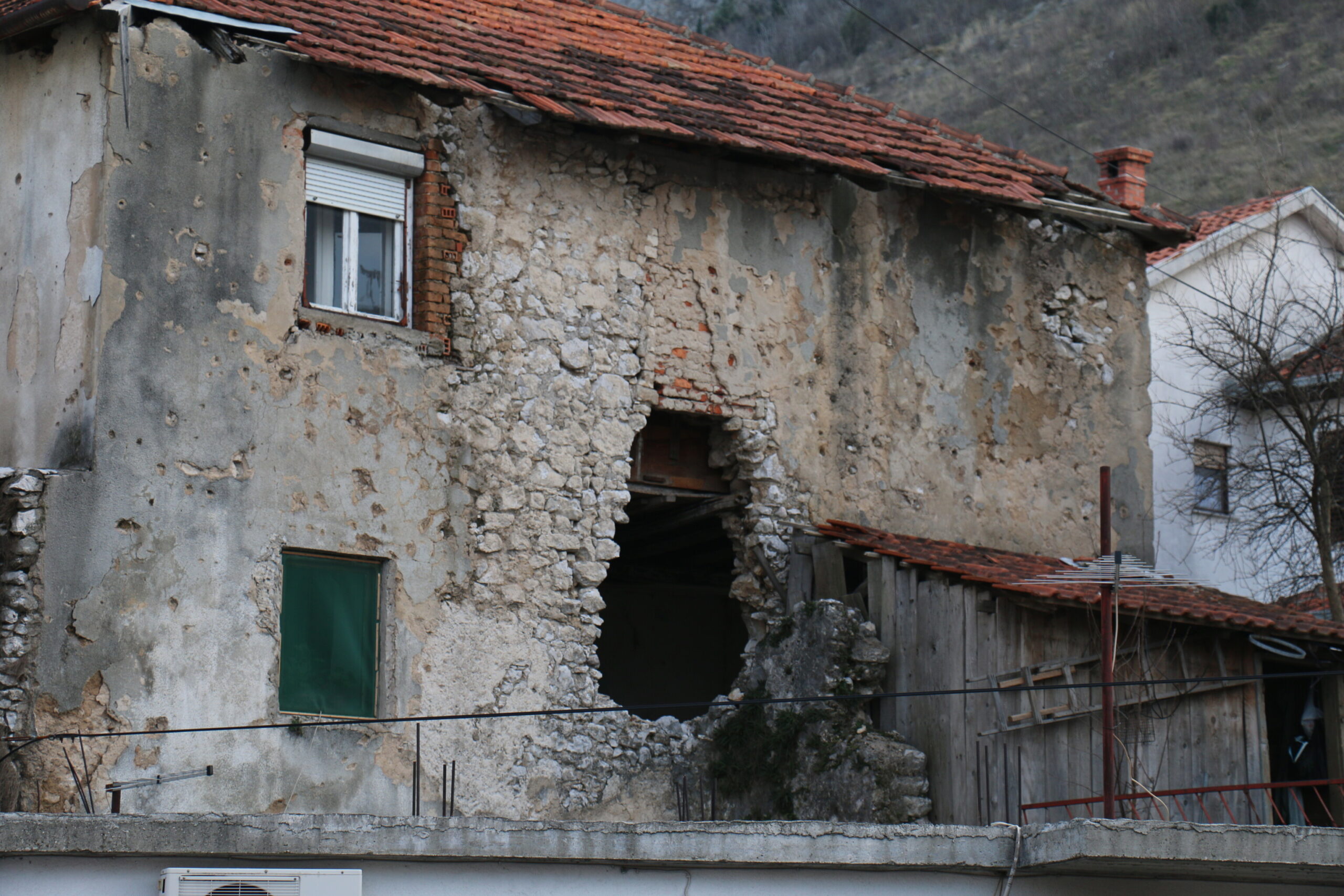
5 Reasons To Visit Bosnia & Herzegovina
- Affordable Travel: Bosnia is an incredibly budget-friendly destination, offering excellent value for accommodations, dining, and activities compared to other European countries. See more under the Travel Cost section below to understand how much you will spend here.
2.
Stunning Natural Beauty: From the majestic peaks of the Dinaric Alps to the crystal-clear rivers and waterfalls, Bosnia’s landscapes are a paradise for anyone who enjoys hiking, swimming or just driving through scenic landscapes. My favorite places include the Sutjeska National Park and Kravice Waterfalls (read more below).
3.
Delicious Cuisine: If the two reasons above weren’t enough to get you to book a flight Bosnia & Herzegovina, the Balkan cuisine in Bosnia is one of my absolute favorites with its unique blend of Eastern and Western influences, with dishes like ćevapi, burek, and traditional sweets like baklava. The country’s coffee culture, (there is literally a cafe on every corner!) inherited from the Ottomans, is also an essential part of daily life.
4.
Historical Sites: The country’s mix of Eastern and Western influences is a recurring theme, which also becomes apparent when you visit many of its historical sites, from the iconic Stari Most (Old Bridge) in Mostar to the mix of Ottoman-era and Austro-Hungarian architecture in Sarajevo, and the medieval castles scattered throughout the region.
5.
Endless Activities: Whether you’re into hiking, rafting, skiing, or simply sitting at a cafe and soaking in the local culture, Bosnia is one of those countries where you can make several trips and still having only scratched the surface of things you can do.
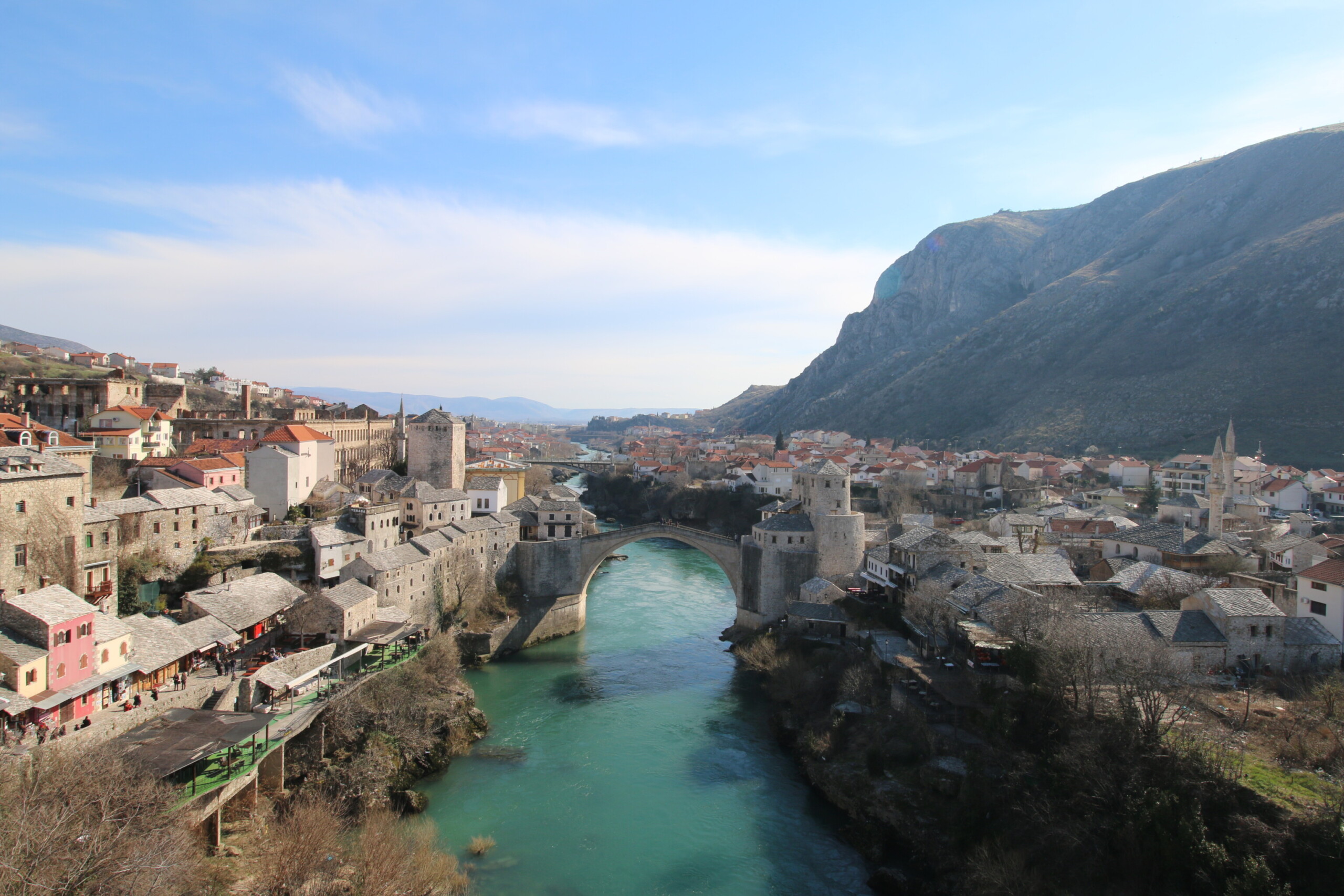
Top Things To Do
Sarajevo
Sarajevo is the unique capital of Bosnia & Herzegovina, which should be a stop on your trip to Bosnia. Baščaršija, is the old bazaar of Sarajevo, where you can explore Ottoman-era architecture, mosques, and bustling markets. Don’t miss the Gazi Husrev-beg Mosque, a stunning example of Ottoman architecture, and the Sarajevo Tunnel Museum, which offers insights into the city’s siege during the 1990s. Overall, Sarajevo offers heaps of charming cafes and restaurants where you can experience traditional Bosnian cuisine, such as cevapi and burek. If you want a more off-the-beaten path activity is suggested that you check out the abandoned Bobsleigh track in Sarajevo. Check out my article where I explain in great detail all the things you need to know before you visit.
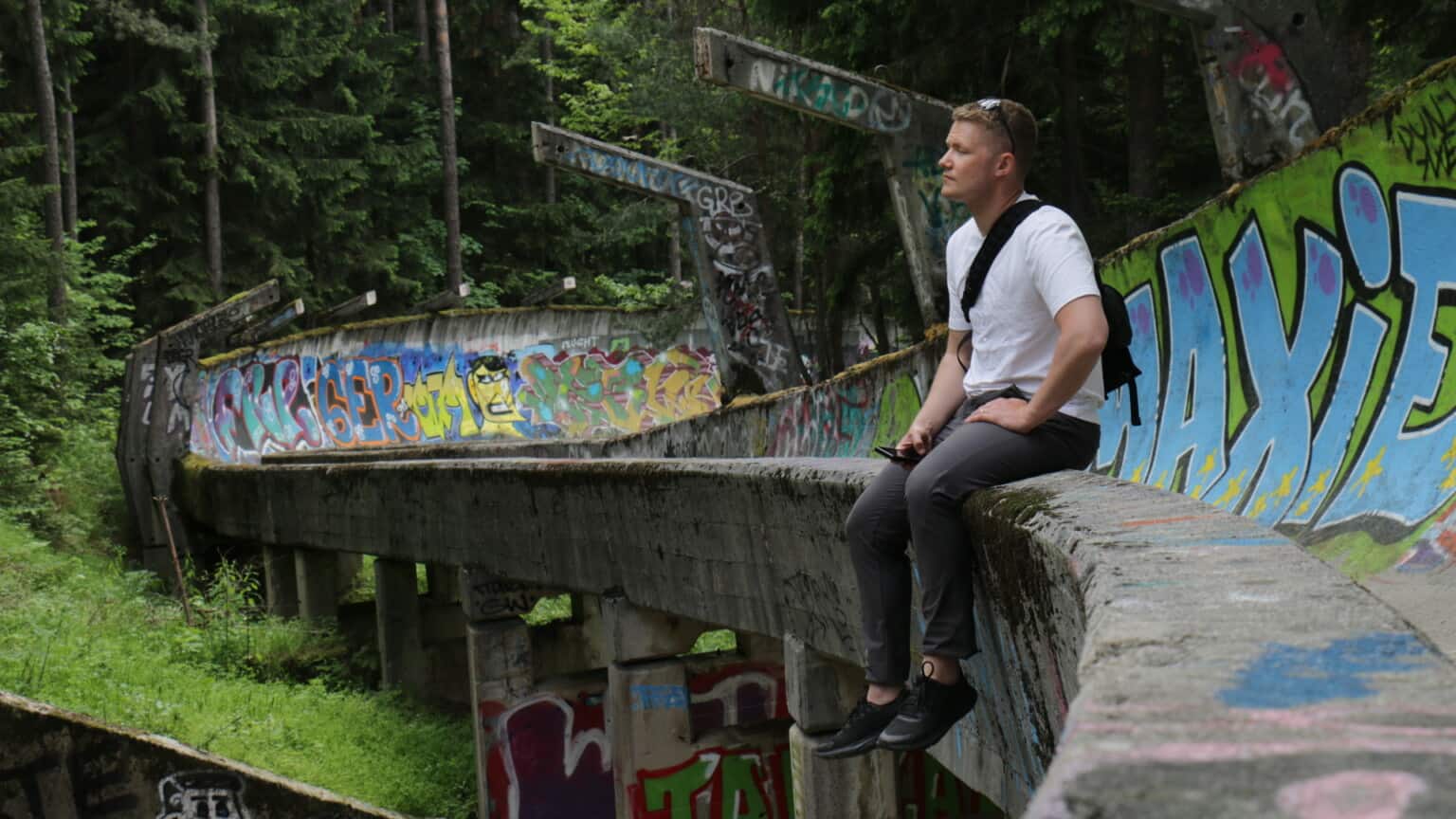
Mostar
Mostar, I believe is one of the best cities to visit in the whole of Bosnia, not only is it a beautiful city with the iconic Stari Most (Old Bridge), a UNESCO World Heritage site, but it also gives you the option to take day trips to many of the most visited sites of the country, such as the Kravice Waterfalls, Blagaj Tekija and the Catholic pilgrim destination Medjugorje. The bridge in Mostar is a symbol of the city’s resilience and is surrounded by charming cobbled streets, historic buildings, and vibrant markets. Watching the local divers leap from the bridge into the Neretva River is a thrilling experience. While in Mostar, explore the old town with its mix of Ottoman and Austro-Hungarian architecture, and visit the Koski Mehmed Pasha Mosque, where you can climb the stairs to the top of the minaret for panoramic views of the city.
Kravica Waterfalls
Explore the stunning Kravica Waterfalls near the town of Ljubuški. It’s Bosnias version of the famous Plitvice waterfalls in Croatia, but without the crowds. This natural wonder offers beautiful cascades, crystal-clear pools, and also opportunities for swimming and picnicking. The lush surroundings make it a perfect spot for relaxing and simple enjoying nature. Nearby, you can also visit the historical Roman town of Mogorjelo and the medieval fortress of Počitelj.
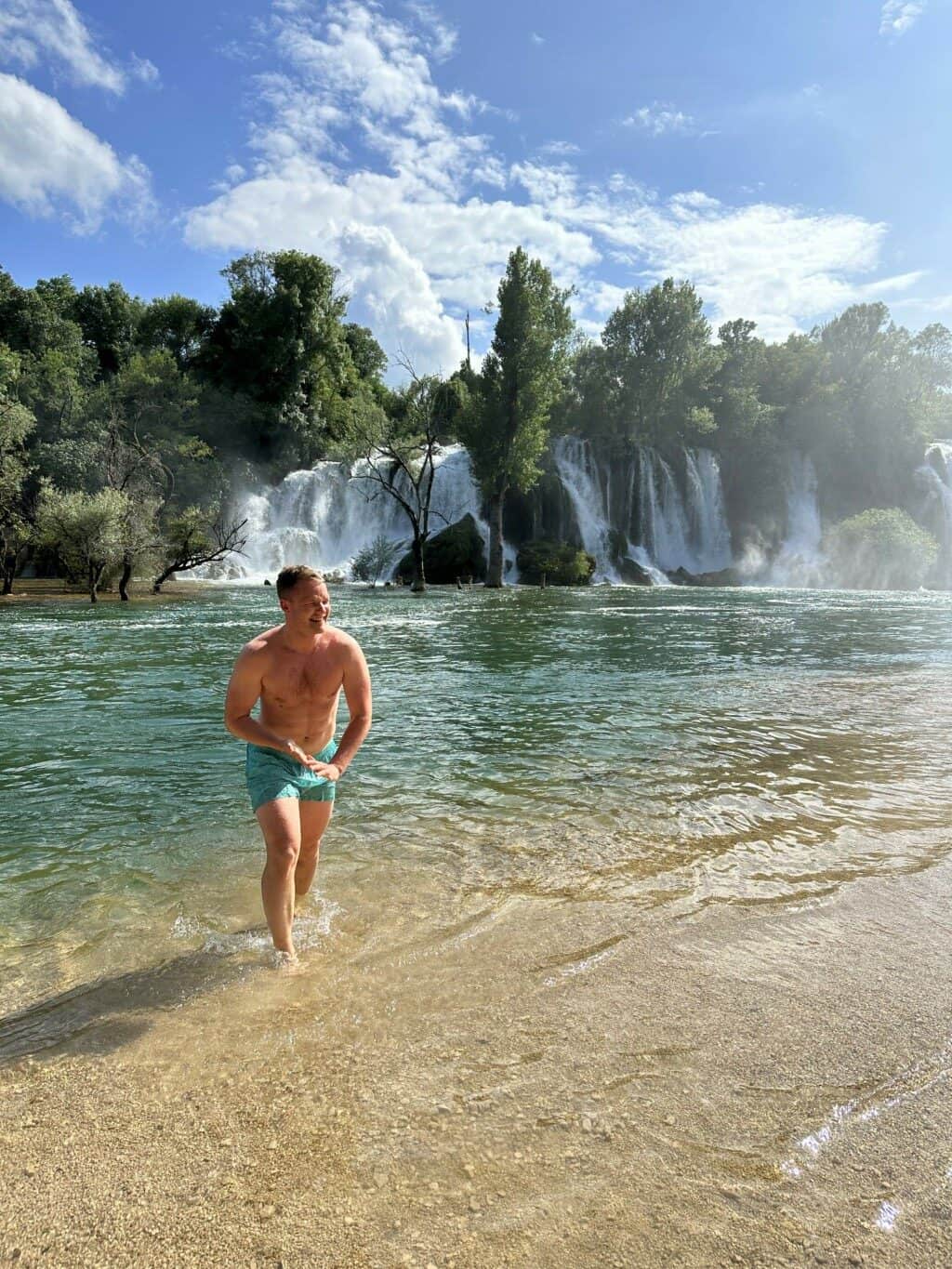
Una National Park
Discover the natural beauty of Una National Park, known for its pristine rivers, waterfalls, and lush forests. It’s a perfect destination for outdoor activities such as rafting, hiking, and wildlife watching. The park’s highlight is the stunning Štrbački Buk waterfall, and the beautiful Martin Brod area with its cascades and historical monastery. The park also offers opportunities for fishing, cycling, and exploring its rich biodiversity.
Blagaj Tekija
Visit the Blagaj Tekija, a historic and picturesque Dervish monastery built into a cliff at the source of the Buna River. The setting is serene and has unique architecture, which makes it into one of those instagrammable must-see attractions. The monastery dates back to the 16th century and nearby you can enjoy a meal at one of the riverside restaurants while taking in the stunning views of the turquoise river and the monastery.
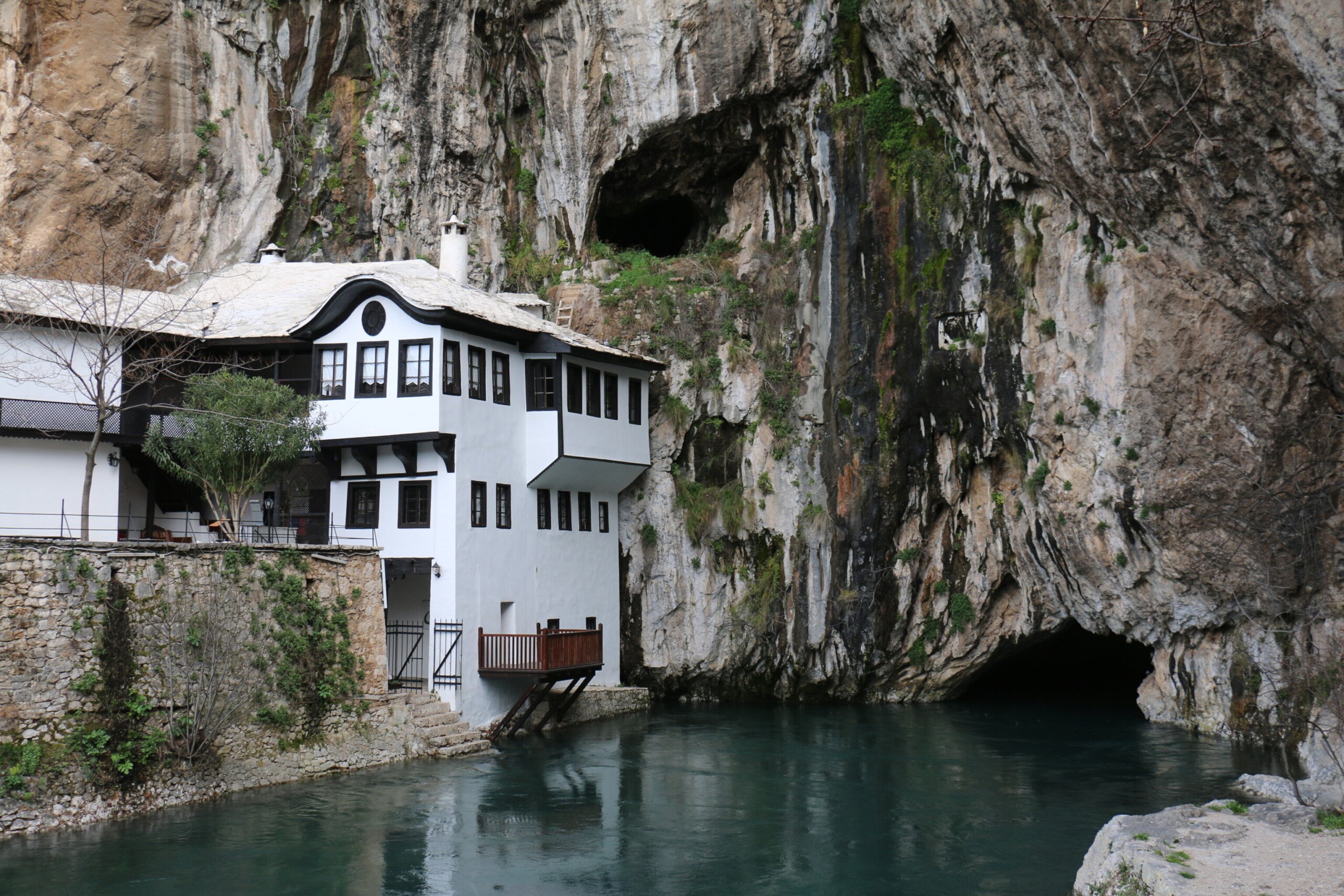
Trebinje
Discover the charm of Trebinje, a picturesque town in the southern part of the country, approximately 2 hours from Mostar, known for its Mediterranean climate and historic sites. Wander through the old town with its beautiful stone buildings, visit the Arslanagić Bridge, and explore the Hercegovačka Gračanica, a stunning Serbian Orthodox monastery offering panoramic views of the town and surrounding vineyards. Trebinje is also a great base for exploring nearby wine routes and tasting local wines.
Jajce
Visit the historic town of Jajce, famous for its impressive Pliva Waterfall, which is located in the heart of the town. Explore the medieval fortress that offers panoramic views of the surrounding area. Jajce is also home to the beautiful Pliva Lakes, where the gorgeous Mlinčići water mills are located, which you should not miss out on, just check out the image below.
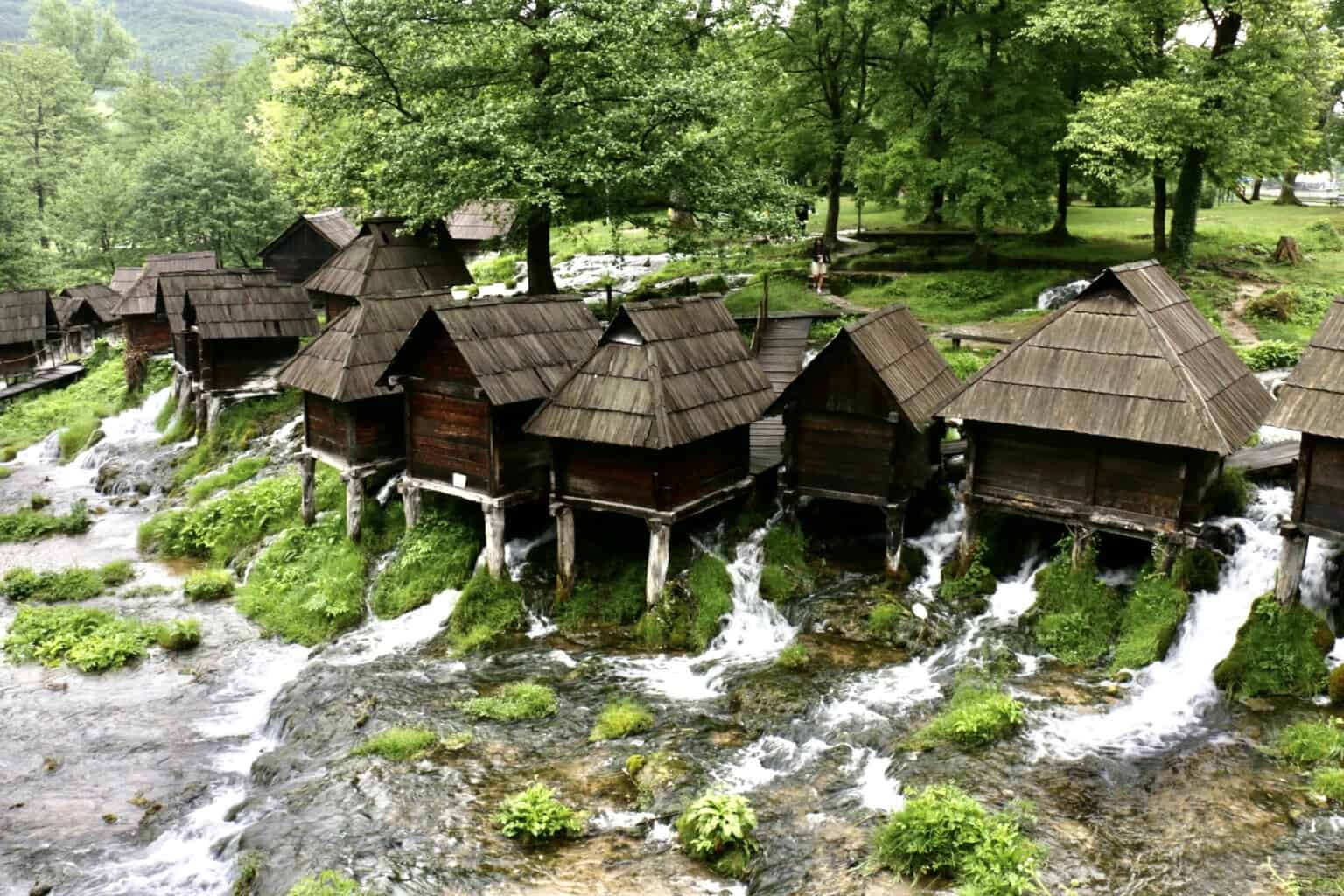
Vjetrenica Cave
Vjetrenica Cave, is the largest and most famous cave in Bosnia & Herzegovina (7 km in total!), located in the Popovo Polje region. The cave is known for its stunning stalactites, stalagmites, and unique biodiversity, including the endemic olm, a rare aquatic salamander. Guided tours take you through the main sections of the cave, showcasing its geological wonders and rich history.
Sutjeska National Park
If there is one place in Bosnia & Herzegovina that feels like straight out of a Jurassic Park movie it’s Sutjeska National Park, the oldest national park in Bosnia & Herzegovina. It’s known for its dense forests, deep canyons, and the towering Maglić mountain, the highest peak in the country. The park is also home to the Perućica rainforest, one of the last primeval forests in Europe. Hiking trails range from easy walks to challenging climbs to the top of Bosnia, and the park’s wildlife includes bears, wolves, and various bird species. Make sure to check out my article on Sutjeska National Park, where I describe more in-depth how to get there and what to do.
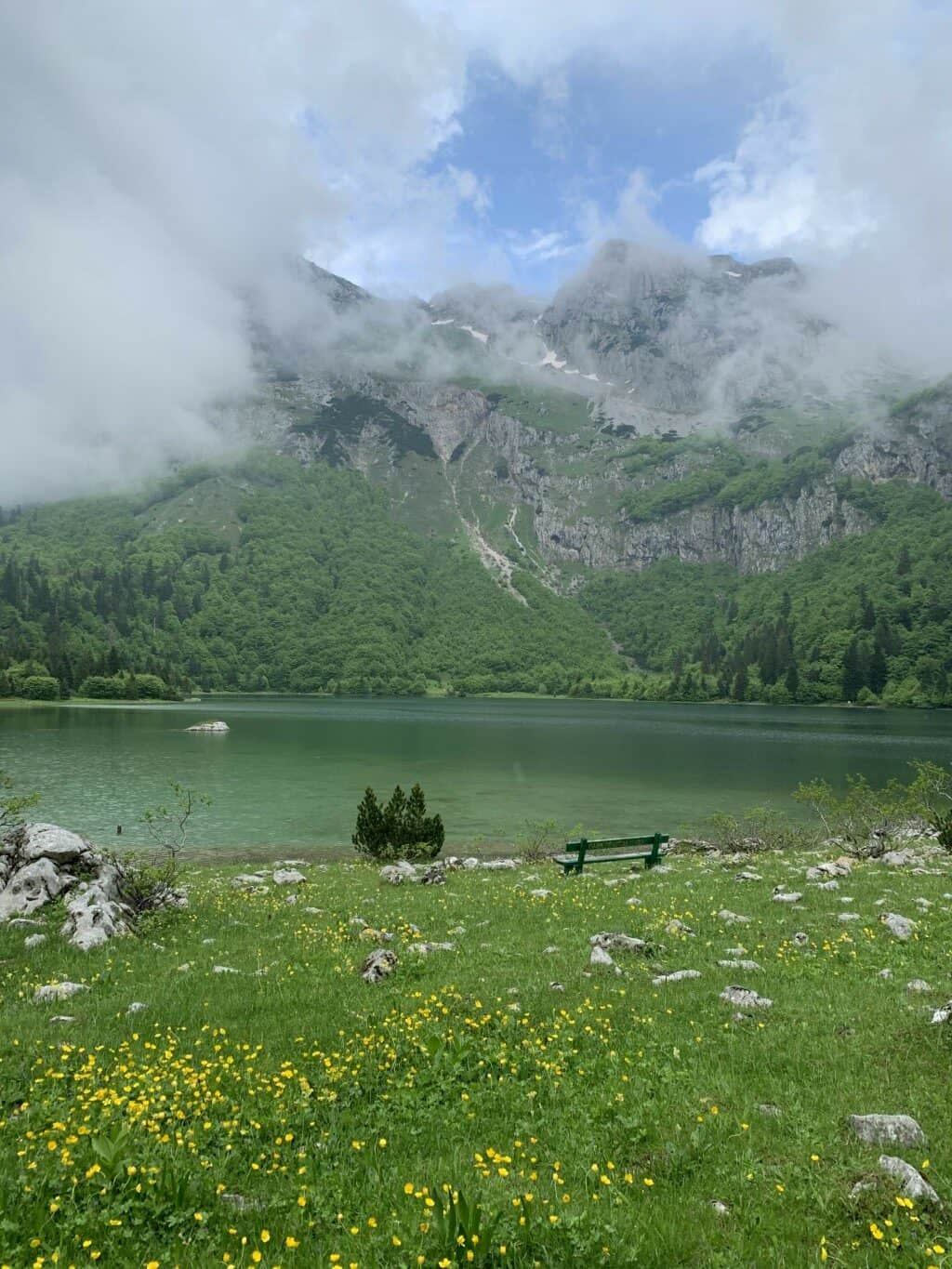
Neum
While Croatia holds nearly all of the coastline in front of Bosnia to the Adriatic Sea, one small pocket known as Neum belongs to Bosnia & Herzegovina. Neum offers beautiful beaches, clear waters, and a range of water sports activities just like in the neighboring Croatia, however the town is an affordable alternative to its more expensive neighbor, with numerous hotels, restaurants, and cafes along the promenade.
Travel Costs
In contrast to it’s neighbor Croatia, Bosnia & Herzegovina is a very affordable travel destination. Below you will find a breakdown of the daily expenses for different budgets:
Accommodation
Bosnia & Herzegovina offers a wide variety of accommodation options, ranging from hotels to fully equipped apartments rented by private hosts. For budget travelers, hostels and budget hotels are available for around 40 BAM per night, especially in major cities like Sarajevo. These budget options typically include basic amenities such as shared bathrooms and free Wi-Fi.
If you’re looking for more comfort, mid-range accommodations are priced around 100 BAM per night, offering features like private bathrooms and breakfast, whether you choose an apartment or a hotel. For those seeking a more luxurious experience, upscale hotels are available for 200 BAM or more per night, providing premium amenities and services.
Accommodation prices in more popular destinations like Sarajevo and Mostar can be higher during peak tourist seasons, which is typically in summer (June to August) and around major holidays. Try to travel outside of this period to get the most bang for your buck!
Food
Eating out in Bosnia & Herzegovina is largely inexpensive, especially in comparison with prices in the West. Budget options, like street food and local cafes, cost around 5-10 BAM per meal. For a mid-range dining experience, expect to pay 20-40 BAM per meal, including an appetizer, main course, and a drink. Fine dining experiences can cost 60+ BAM per person, offering gourmet meals at places like Restaurant 4 Sobe Gospođe Safije in Sarajevo.
Transportation
If you are traveling anywhere else in Bosnia other than the main town of Sarajevo or to Mostar from Croatia, I would recommend that you rent a car. It is inexpensive and it also gives you the most freedom and you will be able to cover a lot more ground with a car. Renting a car costs around 20-50 BAM per day, with fuel priced at approximately 2.50 BAM per liter.
If you don’t like driving a car abroad, the buses are the main option to travel in Bosnia and they are pretty comfortable. Bus tickets between Sarajevo and Banja Luka costs around 40 BAM. Between Sarajevo and Mostar, there is also the possibility to travel by train, which is a very scenic route. Tickets costs around 20 for a 2nd class ticket.
Cities are usually small enough to reach everything within walking distance, so there is really no need to use the public transportation system as a tourist.
Activities
Bosnia & Herzegovina is easy on the wallet when it comes to activities, museums and historical sites often charge between 0-10 BAM for entry. Popular activities such as rafting, costs around 50 BAM. Entrance to the Kravice waterfalls in the high season costs 20 BAM, in winter and low season the entrance is free. Vjetrenica Cave costs 20 BAM. Many other activities such as the Mlinčići water mills and the abandoned bobsleigh track in Sarajevo are free of charge.
| Expense | Budget | Mid-Range | Luxury |
|---|---|---|---|
| Accommodation | 40 BAM (Hostels) | 100 BAM (Hotels) | 150+ BAM (Luxury Hotels) |
| Food | 5-10 BAM (Local Cafes) | 20-40 BAM (Mid-Range Restaurants) | 60+ BAM (Fine Dining) |
| Transportation | 2-5 BAM (Public Transport) | 30-50 BAM (Car Rental) | 100+ BAM (Private Transfers) |
| Activities | 0-10 BAM (Museums) | 20-50 BAM (rafting) | 100+ BAM (Exclusive Experiences) |
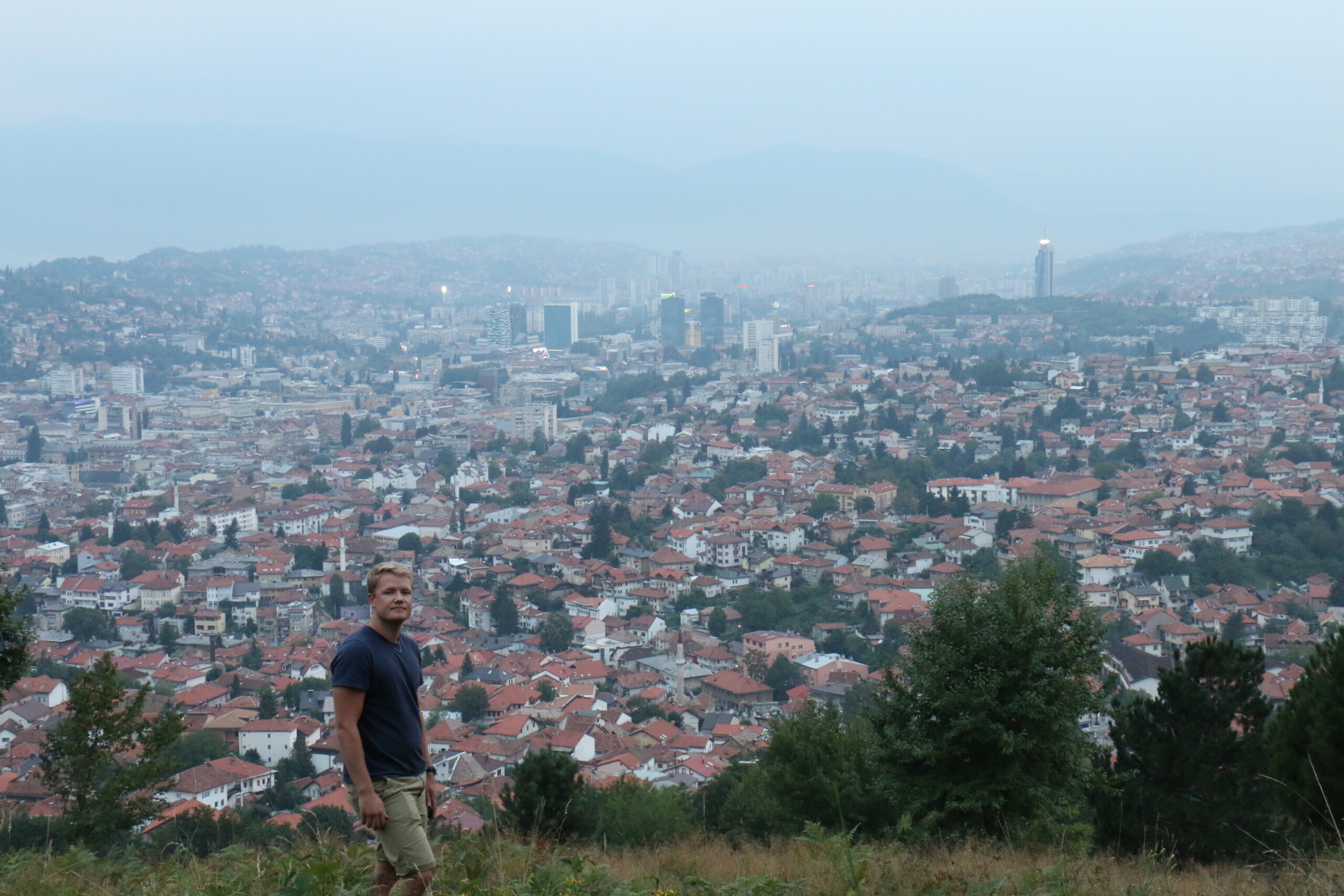
Accommodation Recommendations
Sarajevo
- Upscale:
- Swissôtel Sarajevo: A modern luxury hotel with spacious rooms, excellent service, and stunning views of the city.
- Hotel Monte: Located outside of Sarajevo is this tranquil spa hotel, which is an excellent place to stay if you are looking to relax and enjoy the nature that Bosnia & Herzegovina has to offer.
- Mid-Range:
- Hotel President Sarajevo: Located near the Latin Bridge, this hotel offers comfortable rooms and a central location.
- Courtyard by Marriott Sarajevo: A modern hotel with great amenities and a convenient location close to the city center.
- Budget:
- Hostel Franz Ferdinand: A stylish and affordable hostel located in the city center, offering dorms and private rooms.
Mostar
Below is some of my recommendations for accommodation when visiting Mostar.
- Hotel-Restaurant Kriva Ćuprija: A charming hotel located in a historic building near Stari Most, offering comfortable rooms and an on-site restaurant.
- Villa Anri: Stayed here back in 2015 when I visited Bosnia and Mostar for the first time. The owner even picked me up at the central bus station in Mostar. They offer cozy rooms, a great breakfast and a terrace overlooking the Stari Most.
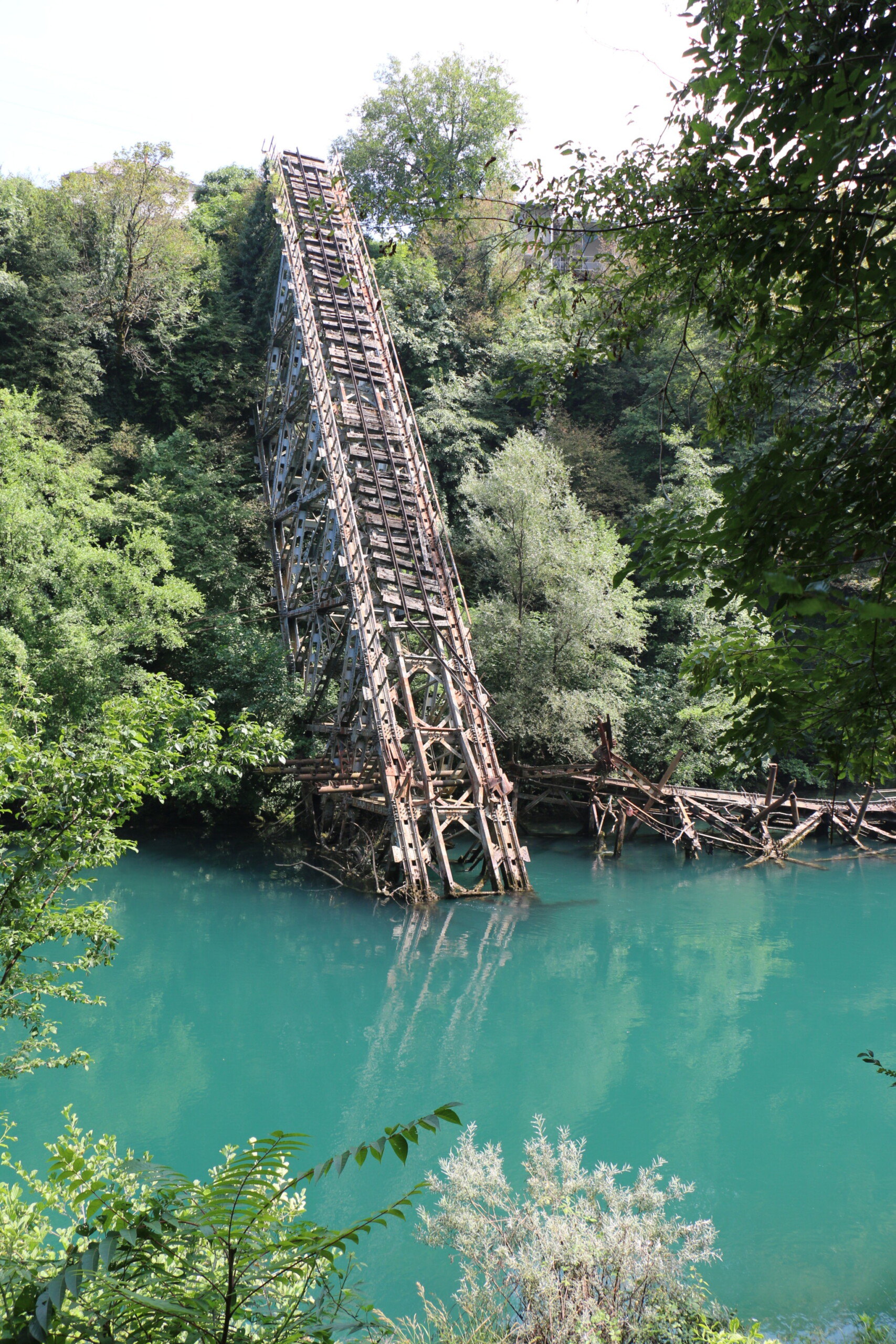
When to Go
Spring (April to June): Mild temperatures and blooming landscapes make this a great time for sightseeing and outdoor activities. Spring is also less crowded than summer, offering a more peaceful experience. June is also great if you want to go hiking in any of the national parks.
Summer (July to August): The high season in Bosnia, but also with the warmest weather. I would personally avoid this period since temperatures can reach the high 30’s (celsius).
Autumn (September to October): Enjoy colorful foliage and fewer crowds. Autumn is a beautiful time to visit any of the national parks and explore the countryside. The weather is still warm so you won’t be freezing.
Winter (November to March): Winter is the low season and a great time to visit if you want to go skiing in the mountains in Bjelašnica or Jahorina. Sarajevo and other towns are beautifully decorated for the holiday season.
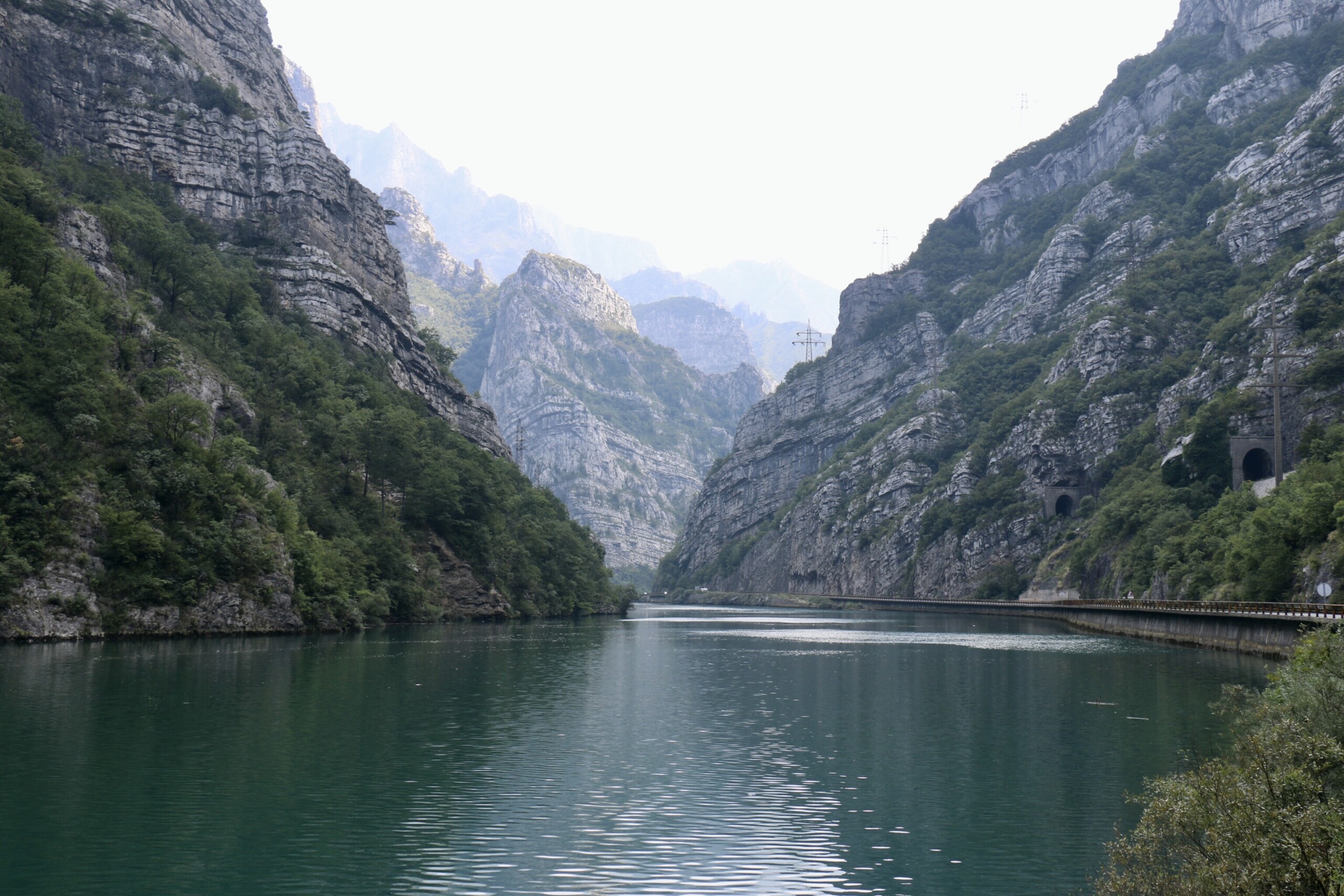
Safety
Bosnia & Herzegovina is generally a safe country for travelers. Here are a few tips to keep in mind:
- Crime: Robberies and break-ins, both in houses and cars, do occur, but personal safety is generally good. Pickpocketing and bag thefts are not uncommon, especially in the central parts of cities.
- Tap water: Tap water is generally safe drink in most area in Bosnia & Hersegovina, however I usually by bottled water when I am in the country to be on the safe side.
- Emergency Numbers: Familiarize yourself with local emergency numbers (Police: 122, Medical: 124). In case of an emergency, these numbers can be dialed from any phone.
If you want to know more about the safety and what to look out for in Bosnia & Herzegovina, make sure to check out my article: Is it safe to travel to Bosnia?
Travel Resources
- Skyscanner: An excellent tool for finding the cheapest flights and comparing multiple airlines to get the best deal.
- Booking.com: A reliable platform for finding and booking accommodations, with a wide range of options to suit every budget.
- Rentalcars.com: Perfect for comparing car rental prices and securing the best deal for your road trip adventures.

